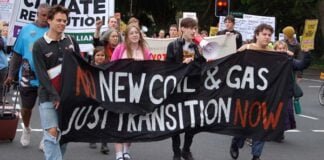JULIA GILLARD, Tony Abbott and Anna Bligh spent much of the Christmas period posing for the cameras in flood-ravaged Queensland. There was plenty of talk about tragedy, the need for compassion and the resilience of the “Australian spirit”.
Yet no political leader dared mention climate change—a major factor in the severity of the floods.
Large areas of Queensland have suffered from routine floods throughout history, but nothing on record matches the scale of the current disaster.
Nobel prize-winning climate scientist David Karoly explained to the ABC:
“We have very variable climate in Australia. What we are seeing… is a change in the pattern of these extremes. There are more hot and more wet extremes in northern Australia and more hot and more dry extremes in southern Australia. That pattern is exactly what we would expect from climate change driven by more greenhouse gases in the atmosphere.”
NASA’s annual climate report called 2010 as the hottest year on record. Only one year in the whole of the 20th century, 1998, was hotter than any year in the 21st.
Global warming is heating up the ocean. The Bureau of Meteorology’s (BOM’s) annual Australian Climate Statement released on January 5 showed that 2010 sea temperatures in the Asia-Pacific region were the highest on record. More evaporation from warming oceans means higher levels of precipitation in the atmosphere.
Such dramatic shifts in climate fundamentals mean that all “natural” weather events are now in some way influenced by human induced climate change.
The main factor in the current floods is the development of an La Nina weather system in the Pacific Ocean, historically responsible for tropical cyclones and flooding. But as Kevin Trenberth, an IPCC author from New Zealand’s National Centre for Atmospheric Research, explains:
“There is a systematic influence on all of these weather events now-a-days because of the fact that there is [more] water vapor lurking around in the atmosphere than there used to be say 30 years ago. It’s about a 4 per cent extra amount, it invigorates the storms, it provides plenty of moisture for these storms”.
The BOM study also shows that in 2010 large areas of Queensland and the Northern Territory had recorded the highest annual rainfall in history, while southwest WA experienced the driest year on record.
Much of Queensland had been waterlogged for months before the floods. A series of tropical cyclones just before Christmas spurred on the flooding.
It is a situation governments are perfectly aware of.
A report quietly released by the Queensland government in November concluded, “with our changing climate, extreme flooding events are likely to become more intense.” Australia’s chief scientist Penny Sackett released another report that month that concluded the, “frequency and severity of [La Ninas and El Ninos] we do expect to increase.”
Yet both politicians and the corporate media have kept any discussion of climate change out of their response to the floods.
Coal country
Coal is at the heart of Australian capitalism, both as a major export earner and a cheap source of domestic power. Despite the scale of the disaster, questioning the viability of the coal industry is literally unthinkable for the Australian ruling class. Rather than move to cut Queensland’s emissions, Anna Bligh has instead praised Xstrata coal for a $1 million donation to the relief effort.
Massive resources are being deployed to repair infrastructure for 40 Queensland coal mines whose operations have been closed by flooding. The government is very concerned that global coal supply will remain down almost two millions tonnes every week that Queensland stays underwater.
Yet Bligh has taken virtually no steps to prepare communities for the onslaught. In Emerald, a coal-mining town that has boomed over the last decade, whole suburbs were built on a flood plain that is now underwater.
In the regional city of Rockhampton, the council admitted last year that it was relying on an “out of date” flood study and lacked the funding to work on a proper disaster management plan.
Julia Gillard has warned of broader budget cuts following expenditure on flood relief, but there no signs she will cut the $9 billion of annual government subsidies to the fossil fuel industry. Instead she is preparing to deliver another version of the worse than nothing Carbon Pollution Reduction Scheme through the government’s carbon price committee.
The Royal Commission into Victoria’s disastrous 2009 bush fires buried submissions from climate scientists. They were not called before the inquiry and their evidence was excluded from the final report. We cannot allow a similar whitewash to take place this time. The climate movement must fight to expose the truth behind the floods and ramp up the campaign for investment in renewable energy.
Paddy Gibson






